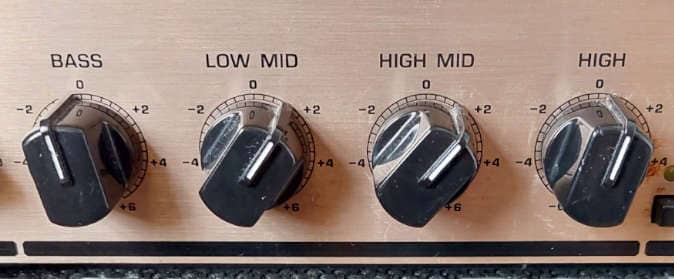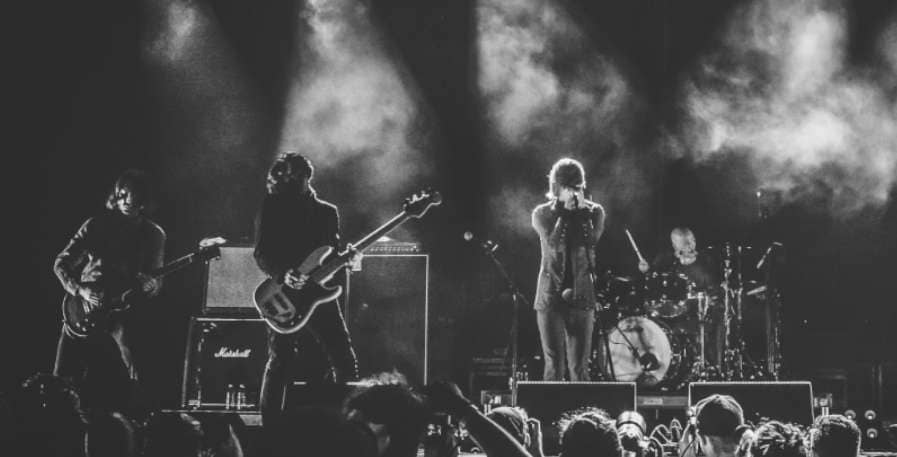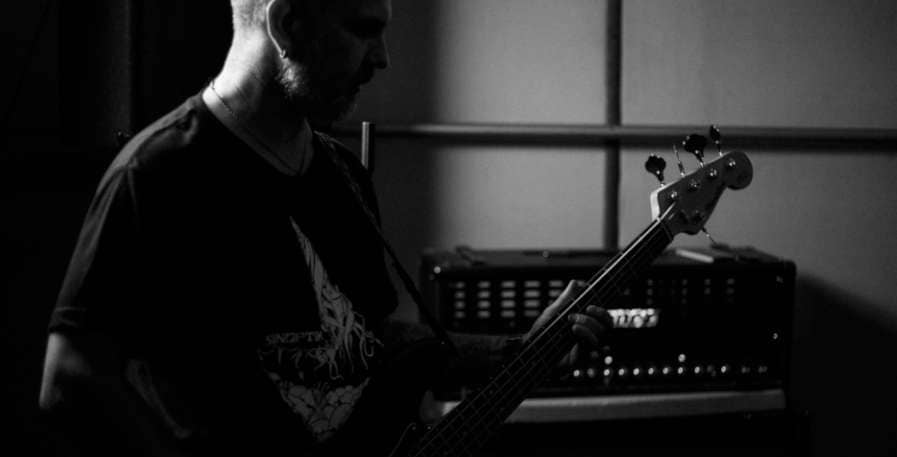This post contains affiliate links
As a metal bassist, it`s crucial that your tone is heavy and suits the genre. The first step to achieving this is to get your EQ and amp settings right.
After playing metal bass for more than 15 years now, I can tell you that this can be harder than it sounds. The reason for this is that good bass EQ is dependent on what the rest of the band sounds like.
Therefore, I`ve written this guide to help you out with this. First, I`ll show you what to pay attention to when adjusting your amp settings and bass knobs for playing metal. Then, I`ll show you a good starting point for where to set your bass, mid and treble.
We will also take a look at some great metal bass tones to emulate. Lastly, we`ll take a look at how to use distortion as a metal bassist, and how to avoid some common mistakes when doing so.
How do you EQ metal bass?
When playing bass in a metal band, your EQ should be set to fill in the frequencies that the other instruments don’t cover.
For example, if the guitars are taking up a lot of mid-range, you can put more emphasis on the bass and treble frequencies to round out the sound of the band. If the guitars are heavy on the low-end you might instead turn up the mid and high frequencies.
The result of this will be that your band sounds fuller and more cohesive. One band that nails this balance well is Pantera. Rex Brown`s bass is always EQ`d so that it doesn`t clash with the guitar or drums. Rather, it supports both while still sounding clear in the mix:
If you`ve ever thought a song sounded too hollow, noisy, or just all over the place, the reason was likely poor EQ between the instruments. Few listeners will think “Oh, that band sure was lacking in the 800-1000 Hz range“. However, they can still feel blindspots like this, even though they can`t put it into words.
With that said, the following EQ settings will give you a great starting point for a solid metal bass tone:

Bass : 4-5 (11:00-12:00)
It can be tempting to think that more low-end results in a heavier sound. However, I find it better to think of the low-end as adding more boominess.
While that can sound like a good thing for metal, too much of it can quickly make your tone overpowering. The result is often an unwanted wall of low frequencies that sounds disruptive to the overall sound of a band. This holds especially true if the guitars use a lot of low-end.
You do want some power and boominess to your tone though, so you can`t have too little low-end either.
Thus, depending on what type of metal you play, keeping the low-end at 5, or scooping it slightly is a good starting point. Genres like melodic death metal can benefit from a slightly higher low end while turning it down will give you more of an old-school heavy metal sound.
Furthermore, if you play in Drop D or higher, turning the low-end up slightly can work well. This is because the boominess of the low-end will be less noticeable at higher pitches.
Thus, I recommend trying out what setting the bass to ~6 sounds like if you play in E or Eb standard.
Mids: 6-7 (01:00-02:00)
Played on its own, a bass guitar with the mids boosted doesn`t necessarily sound too fit for metal. However, these frequencies add a lot of warmth, character, and punch to your sound when put in the context of a full band.
Thus, while some metal bassists like scooping their mids, I find that this often makes the tone of the bass lifeless and unpronounced in the mix. Lowering the mids will thus generally make it harder to cut through the sound of the guitars.
Related reading: The Reason You Can`t Hear Bass in Metal Songs
Therefore, I find that turning the mids up to 6 or 7 is a good starting point. This will give your tone enough character to not sound dull, and enough cutting power to not get drowned out in the mix.
Treble: 5-6 (12:00-1:00)
A bass guitar with the treble frequencies turned way up can sound thin and obnoxious on its own. However, when a whole metal band is playing together, this thinness will sound vastly different and add a much-needed brightness to the bass tone.
In general, it is thus preferable to turn your treble slightly up. This holds especially true when tuning to C# or lower. This is because instruments start to become harder to distinguish when tuning below this point.
I recommend listening to how much brightness the treble gives your tone when playing with a full band. I find that turning it up to about 6 (13:00 o clock) is a good starting point, and then I work my way up or down from there.

The best metal bass tones
Below are 5 metal bassists that have an amazing bass tone. They are all vastly different and thus showcase how versatile the bass can be in metal. Thus, chances are good that you will find a fitting tone to emulate among these bassists:
- Justin Chancellor (Tool, 1995 onward) – Heavy, adaptive, and hard-hitting tone. A good choice if you are looking for a tone with a lot of character to it that can be used in most forms of metal.
- Cliff Burton (Metallica, 1982-1986) – Dark, pronounced, and distorted tone. Great bassist to emulate for playing thrash metal and other sub-genres with fast tempos.
- Peter Steele (Type O Negative, 1989-2010) – Warm and fuzzy tone that takes up a lot of space in the mix. Great if you are in a band with just 1 guitar player, or for slow, droney, and heavy music.
- Martín Méndez (Opeth, 1997 onward) – Sophisticated tone with emphasis on notes sounding clear. Fitting player to emulate if you don`t want to rely on distortion to sound heavy or if you are looking to play melodic and progressive types of metal.
- Rex Brown (Pantera, 1982-2003) – Hard-hitting and heavy metal tone. If you are looking for a punchy and rough sound that works well for breakdowns as well as fast riffs, Brown is the perfect bassist to emulate.
Also, if you are looking to play a specific sub-genre of metal, I recommend listening to what type of bass tone is commonly used in it. This way, you will get a clearer idea of what will work for that specific genre.
I say this because metal is a broad genre of music. One type of tone could sound amazing in speed metal but feel lackluster in metalcore. Thus, even if you find the greatest metal tone ever, it will not matter if it doesn`t suit the type of music you are looking to play.
For more great bass tones to draw inspiration from, check out my list of The 16 Best Metal Bass Songs Ever.
Bass Guitar Distortion
Distortion is a staple of the metal genre and is commonly used by metal bassists. Some bassists opt for a distortionless and cleaner tone when they find that their guitarists are providing enough distortion already.
While distortion is a big part of what makes metal sound like metal, it is also a commonly misunderstood effect by bass players. In particular, bassists often use way too little or way too much of it.
Avoiding distortion altogether can be a fitting choice in many sub-genres of metal. However, some bassists who chose to not use distortion have a smooth and warm tone that could have benefited from the extra punch that distortion would have provided.
On the other hand, there are those who rely on a lot of distortion to sound as heavy as possible. While heavy use of distortion use can work well, this can also make the overall sound of the band messy. The result of this is that the bass and guitars blend too much into one another and become hard to distinguish.
Thus, my general recommendation is to use a moderate amount of distortion for most sub-genres. It is not a necessity, but more often than not it will elevate your tone and make it more suitable for the genre.
As for pedals, there are a lot of affordable options out there that work more than well enough. It is also common for bassists to use distortion pedals that are marketed as guitar pedals.
If you don`t have a distortion pedal, my recommendation is the AZOR Heavy Metal Distortion. It`s a simple pedal specifically designed for metal. It`s a great choice for bassists that want flexibility, as it can produce both a classic heavy metal distortion or a more modern-sounding form of it.
Conclusion
When it comes to bass amp settings for metal, you have both flexibility and limitations.
On one hand, you can tweak the EQ a good bit while retaining a heavy and pronounced tone. On the other hand, adjusting your amp settings too much can lead to the bass and guitars trying to dominate the same frequencies.
Thus, I recommend starting with the bass at 4-5, mids at 6-7, and treble at 5-6. This is a great starting point, but chances are that you will need to make slight adjustments depending on the settings of your band.
I recommend working together with your guitarists so that everyone has an EQ that they like, and that sounds well together. The end result will generally be better when everyone is taking each other’s needs into consideration.
Lastly, never turn any knob on your bass or amp all the way up or down. While this can fix the issue of instruments colliding with one another, it will greatly reduce the character of your tone. Thus, when you tweak your EQ, make sure to do it in small increments at a time.
How to set your EQ and amp settings for metal also largely depends on what bass you play. While most active basses have enough tonal flexibility to allow for a heavy tone, some metal bassists prefer the P bass. To learn more about why, continue by reading my guide on Playing Metal On A Precision Bass.

